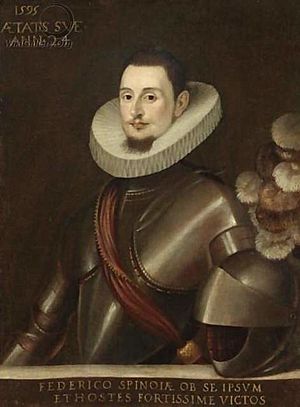Federico Spinola facts for kids
Quick facts for kids
Federico Spinola
|
|
|---|---|

Portrait by Barocci, 1595
|
|
| Born | 1571 Genoa, Republic of Genoa |
| Died | 26 May 1603 (aged 31–32) Sluis, County of Flanders, Spanish Netherlands |
| Allegiance | Spanish Habsburg |
| Service/ |
Armada of Flanders |
| Years of service | 1598–1603 |
| Rank | admiral |
| Commands held | galley squadron |
| Battles/wars | Battle of Sesimbra Bay (1602) Battle of the Narrow Seas (1602) Battle of Sluis (1603) |
| Relations | Ambrogio Spinola (brother) |
Federico Spinola (1571–1603) was a brave Italian naval commander. He served the Spanish Habsburgs during a big conflict called the Dutch Revolt. He was known for trying to use Mediterranean-style warships in the rougher northern European seas.
Contents
Federico Spinola's Story
Early Life and New Plans
Federico Spinola was born in Genoa, Italy, in 1571. He went to the University of Salamanca to study. His family hoped he would become a priest. However, Federico chose a different path. He joined the Army of Flanders. This was a Spanish army that fought in what is now Belgium and the Netherlands. He served under a famous leader, Alexander Farnese, Duke of Parma.
In 1598, Federico traveled to Madrid, Spain. He had an exciting idea. He wanted to build a fleet of special ships called galleys in Flanders. Galleys were long, narrow ships powered by oars and sails. They were common in the calm Mediterranean Sea. Federico believed these ships could be used to invade England.
The Spanish leaders liked his plan. They gave him command of six galleys. In 1599, he sailed these ships to Sluis. This port in Flanders became his main base.
Challenges at Sea
In 1602, Federico Spinola was given eight more galleys. These ships were meant to strengthen his fleet at Sluis. But the journey was very difficult. Only four of the eight ships made it safely to port.
Two galleys were lost during the Battle of Sesimbra Bay. This battle happened while they were sailing. Two more ships were lost later during the Battle of the Narrow Seas (1602). These losses showed how hard it was to use Mediterranean galleys in the rougher, colder waters of northern Europe.
The Final Battle
Federico Spinola's naval career ended on May 26, 1603. He died during the Battle of Sluis (1603). This battle brought an end to his experiment. He had tried to adapt Mediterranean naval fighting to the northern seas.
Remembering Federico
A famous artist named Federico Barocci painted a portrait of Federico Spinola in 1595. A poet named Francisco de Quevedo also wrote a poem. It honored Federico's brave actions and adventures.
See also
 In Spanish: Federico Spínola para niños
In Spanish: Federico Spínola para niños

